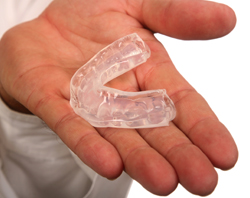Mouthguards

A mouthguard is a piece of equipment worn over your teeth to protect them from injury when playing contact sports. Any athlete playing a sport that could result in a mouth injury should wear one. Mouthguards are required for most MIAA (Massachusetts Interscholastic Athletic Association) sports teams and are recommended by the ADA (American Dental Association) and the MDS (Massachusetts Dental Society). Mouthguards need to be worn at practice as well as games.
Mouthguards are generally worn over the top teeth and are designed to protect against broken teeth. If your child has braces the dentist may recommend a mouthguard for the bottom teeth too.
Mouthguards come in a variety of colors. Most sports teams in Massachusetts require a colored mouthguard (not clear), so the ref, umpire or coach can easily identify if the athlete is wearing them at practice or a competition.
The type of mouthguard you choose to use will impact the level of protection you will receive while playing sports.
Types of Mouthguards
- Stock mouthguards These mouthguards are inexpensive and come pre-formed. They are usually sold in small, medium, large and extra large sizes. They do not fit well because they have not been formed to your teeth. Stock mouth guards are usually bulky and uncomfortable.
- Boil and bite mouthguards These mouth guards come in a pre-formed shape that can be boiled and shaped in your mouth for a customized fit. They can be purchased in most sporting goods stores, and offer a better fit than stock mouthguards.
- Custom-made mouthguards These mouth guards are individually designed and made in your dentist’s office. Of the three types of mouth guards, the custom-made guards are the most comfortable and provide the best protection. An impression of your teeth is taken in the dental office and the guard is specifically made to fit your unique mouth.
Whichever type of mouthguard you decide to use, it should be flexible, tear-proof and comfortable. The mouth protector should fit properly and not impact speech or breathing.
Taking Care of Your Mouthguard
Similar to a retainer, braces, or any other special dental appliance, it is important to take care of your mouthguard by storing it properly and keeping it clean. Here are a few simple ways to keep your mouthguard clean and working correctly:
- Gently scrub your mouthguard after each use with a toothbrush and toothpaste.
- Store your mouthguard in a protective case.
- Do not leave your mouthguard in the sun or in hot water; it may melt or become deformed.
- Do not wear a retainer with your mouthguard. If you wear braces, your dentist will help design a mouthguard to protect your teeth and your braces.
- Do not chew on or cut pieces off of your mouthguard.
Bring your mouthguard to each dental checkup, and your FFD dentist or hygienist can check to make sure it is still in good shape and doing the job it is supposed to do.
Replacing Your Mouthguard
Ideally, mouth guards should be replaced after every sports season. Mouth guards wear down over time and become less effective. It is particularly important for high school athletes to continually change their guards, as their teeth and mouth continue to change. Many adolescents that participate in multiple sports have new mouth guards made when they go to the dentist for their six-month check ups.
During a sports season, you should replace your mouthguard if you notice it has become worn and no longer fits properly.
How to Mold a Boil and Bite Mouthguard
You will need:
- Mouthguard
- Pot of boiling water
- Bowl of cold water
- Tongs
Directions:
- Boil water in the pot. There should be enough water so that the mouth guard does not sit on the bottom of the pan (it could damage the guard).
- When the water is boiling, drop the mouth guard into the pot. Leave it in for 30 seconds (do not go over the 30 seconds as it could damage the guard).
- With tongs, take the mouth guard out of the boiling water and drop in a bowl of cold water for only a moment (2 seconds). This is to slightly cool it so you do not burn your mouth.
- Pick up the mouth guard to make sure it is not too hot for your mouth.
- Place the mouth guard in your mouth and bite down for 30 more seconds.
- Carefully take the mouth guard out of your mouth and run it under cold water until fully cooled.*
*It is important that you handle the warm, molded mouth guard carefully, so it keeps the exact impression shape. Otherwise, it will not fit you properly.


 Website Powered by
Website Powered by